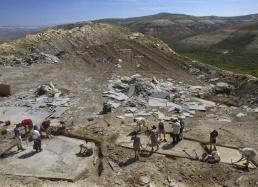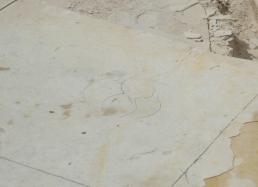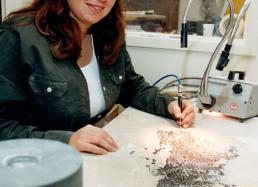From Field to Lab
Fossils from the Fossil Butte Member of the Green River Formation occur on land owned by the State of Wyoming, the Bureau of Land Management, the Forest Service, and the National Park Service, as well as the railroad and private landholders. It's not legal to dig fossils anywhere except on private land with permission of the landowner or special permits. Numerous full-time commerial quarries supply fossils for the market and provide digging opportunities to paleontologists and collectors alike.
Each year, Dr. Grande's crew of Field Museum preparators, volunteers, and students packs up the Museum's trucks and heads west to Kemmerer, Wyoming. Here, they spend two weeks at a site where Dr. Grande has enjoyed fossil-hunting privileges for more than two decades—a five-acre section of the Lewis Ranch quarry leased to commercial excavator Jim E. Tynsky.
The Excavation Process
Fossil excavation is a delicate blend of force and finesse. First, the overburden (loose rock and soil) is bulldozed away, then the "capping-layer" (a layer of hard, black limestone) is removed with sledgehammers to expose blocks of the fossil-bearing rock. Next, thin strips of steel are carefully hammered into the edges of these blocks, taking advantage of naturally occurring separations between layers to peel them up in sheets.
Once a slab is lifted, scientists check for fossils on its underside, as well as on the surface of the newly exposed slab below. A thin layer of rock called the matrix often covers the fossils and acts as both a blessing and a curse. The matrix will protect the fossil as it is sent back to the Museum, but if the sun is overhead, the matrix can make it hard to spot small fossils. That's why the team usually suspends fieldwork between 11:30 a.m. and 3:30 p.m., when the sun is at its highest point.
Any fossil discoveries are marked and cut out from the surrounding rock using a rock saw. And finally, newly freed slabs are carefully packed into wooden crates and brought back to The Field Museum.
Fossil Preparation
Once the crates arrive at the Museum, the fossils are sorted into cabinets where they await preparation so that they can be studied or put on display. A team of preparators works full-time to extract the fossils from their stone tombs.
Working under microscopes, fossil preparators use a variety of tools—including dental picks, needles, and miniature air-powered jackhammers—to carefully remove the matrix. The air-abrasion machine (essentially a pinpoint sand-blaster) comes in particularly handy with Green River Formation specimens because the rock is relatively soft compared to the hard fossilized bone. The very fine stream of powder that shoots from the machine slowly eats the matrix away and leaves the fossil exposed and intact.
A critical specimen can take months or even years to be properly prepared and preserved for display. But once completed, the finished fossil can then be identified and classifed—the final step in the process.





